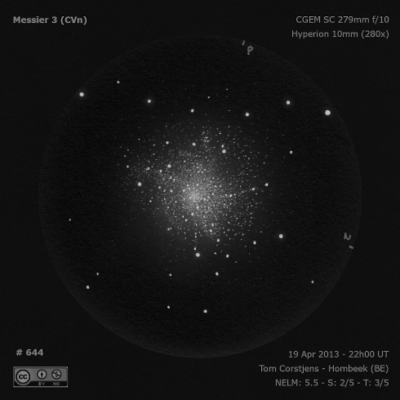
Charles Messier discovered M3 = NGC 5272 = h1663 on 3 May 1764. William Herschel, observing in 1799 with his 10-foot telescope [8" aperture] at 120x, noted "with an aperture of 4 inches it is resolvable; with 5 easily resolvable; with 6 it is resolvable; with 7 and all open the stars may be easily perceived." JH recorded (sweep 417) "A most superb object, diam = 10s time in RA. Not less than 1000 stars 11m and under. They run into a blaze at the centre, and form as it were radiating lines and pointed projections from the mass, with many stragglers."
Several observation at Birr Castle noted dark lanes or dark notes in the cluster. On 16 Feb 1869, C.E. Burton recorded "Radiating branches somewhat resembling a St. Andrew's cross, central mass globular. There seemed to be a bifurcated dark lane in the north segment of the nucleus." On 21 Apr 1873, Ralph Copeland noted "Several small dark holes on the nf side of the central mass."
200/250mm - 8" (5/26/84): the outer halo well resolved into several lanes converging to an intense core. A few faint stars are resolved on the edge of the core.
300/350mm - 13.1" (5/26/84): stunning, several hundred stars resolved at 220x including the dense core.
900/1200mm - 48" (4/19/17): at 375x the 16' field was plastered with an uncountable number of stars. I noticed the brightest star in the core had an orange hue.
Notes by Steve Gottlieb